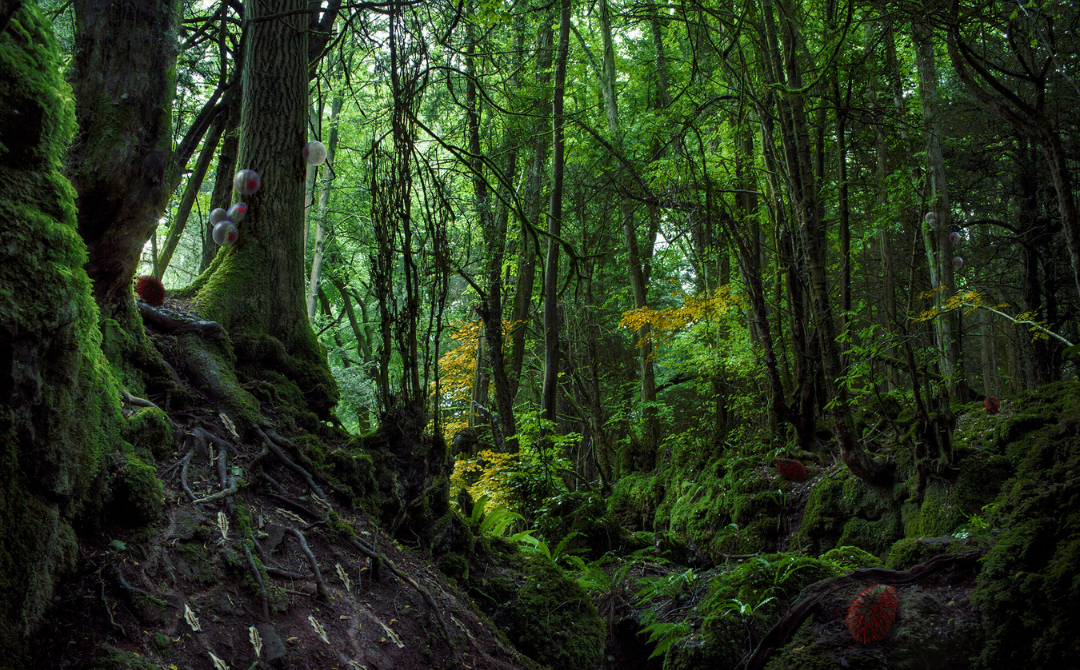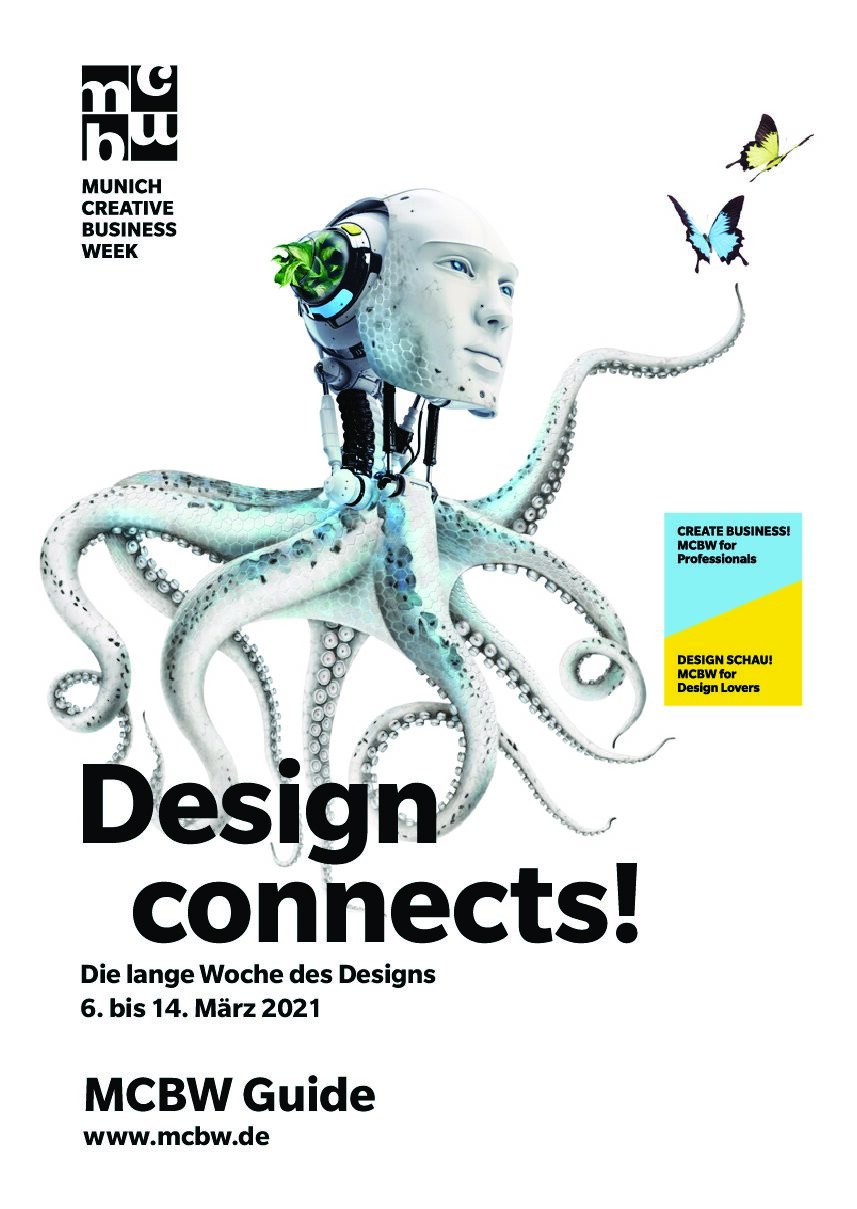Negotiating the future
Speculative Design
The large backlit photograph by British artist Alexandra Daisy Ginsberg shows a jungle-like, densely grown, lush green forest. A piece of wild nature, an intact habitat, you think to yourself. But if you look more closely, you discover even more in the picture. Strange elements — hybrids -, somewhere between a technical product and an animal, make themselves at home on the ground and on the bark of the trees as well as in the foliage.
The apparent living creatures are actually devices that perform certain functions. One, a kind of mollusk patrol, serves as a ’soil bioremediation unit’ and neutralizes the over-acidified soil. The others — small, spiny, thick, worm-like — creatures act as ‘autonomous seed applicators’ and are designed to increase local plant diversity.
To keep the biological and technical cycles separate, all the devices are programmed with a 6‑base DNA code that renders them inedible and prevents consumption by natural species. For each of these inventions, there are precise drawings, explanations of function and scientific explanations, staged in a creative way.
Reality or fiction?
What is it now? Promise of salvation or wishful thinking? Research project or magic? Already reality or still future?
The artistic work ‘Designing for the Sixth Extinction’ (2013–2015) tries to find an answer to the current extinction of species, in which we humans have a significant share. Ginsberg places her work in the field of tension between natural and technological possibilities. What if, instead of trying to protect existing ’natural’ species, we used synthetic biology to develop new organisms for the ‘benefit of mankind’? ‘Designing for the Sixth Extinction’ is an answer to what the wild might look like in a synthetic biological future. Modeled after fungi, bacteria, invertebrates, and mammals, the fictional species are ecological machines to fill the gap left by disappearing organisms.
Ginsberg’s intention with this work is not to suggest a possible solution, but to question that very solution. Not only Ginsberg, but also other designers investigate with their works the complex relationships in and between ecosystems, human as well as non-human habitats and the change of these through new technologies such as biotechnology, but also artificial intelligence, smart technologies or the metaverse. They see their task in the critical and multi-perspective investigation and mediation of possible future life designs, utopian as well as dystopian. The objects they conceive and charge narratively as well as symbolically convey certain scenarios that seem to become reality all at once through their immediate design. They arouse emotions or reactions in us that trigger a sensitization and confrontation with specific issues affecting us as a society.
A future, however distant, becomes not only imaginable and tangible for us humans, but also negotiable. This gives us another basis for weighing up the possible consequences of our decisions. that may result from our decisions. This is not science fiction, but a scientific method that uses the means of design to bring possible futures into focus.
Speculative Everything
Speculative Design uses critical and speculative design methods in its approach to open up a space for thought as well as new possibilities for action for discussion. Important impulses for this expanded field of research and design in design were set by Anthony Dunne and Fiona Raby, who significantly shaped this field.
In their book ‘Speculative Everything: Design, Fiction, and Social Dreaming’ (The MIT Press, 2013), they explore design in its expanded possibilities of speculating, critiquing, and imagining fictional worlds in order to challenge common worldviews and offer a spectrum of future realities for discussion. In doing so, they do not seek to predict ‘the one’ future, but to reveal future spaces of possibility through fictional scenarios.
With the help of design, these become recognizable and tangible, and they can be questioned, negotiated, and subverted. They are not concerned with staging a science fiction, but with thinking further about current real developments.
„Critical design is critical thought translated into materiality. It is about thinking through design rather than through words and using the language and structure of design to engage people.” (Anthony Dunne und Fiona Raby: ‚Speculative Everything’)
This design practice of speculative design has been established since the last 15 years, especially in design teaching and in curatorial work at museums. The work of Alexandra Daisy Ginsberg, who earned her Masters in Design Interactions as well as her PhD by Practice at the Royal College of Art in London, is also exhibited internationally and is in private and museum collections.
In an expanded understanding of design, designers are no longer primarily concerned with serving a consumer-oriented market, but rather with using their conceptual designs and future scenarios to question and overcome preconceived notions in dealing with technologies and the associated social effects. Designers do what they are good at: They design visually powerful images or artifacts and develop future personas and scenarios that stand as symbols of prototypical life worlds. It goes without saying that these are not always promising. The designed models used do not claim to be functioning products, but serve to make complex interrelationships visible.
In this way, speculative design deliberately positions itself outside of an order-based and market-oriented context and can question prevailing practices and conventions such as consumption oriented towards perpetual growth. Its potential lies in not being beholden to any immediate application and having to confirm or reinforce it.
Designing instead of creating
The design discipline has always found itself in the dilemma of wanting to design a livable future on the one hand, and serving as a tool for branding, product innovation, and increasing sales on the other. Many of our problems today have their origins in yesterday’s innovations. As early as 2004, Canadian designer Bruce Mau asked in his publication and exhibition of the same name ‘Massive Change’: “Now that we can do anything, what will we do?”, alluding to the supposed interests and entanglements of business, research and society, but also to the attitude the design discipline takes here. This gives rise to questions such as: What kind of future do we actually want? Who decides about it and who benefits from it? Is there really no alternative to this future?
Recognizing the transformative power of design, design methods are now increasingly being taken up and applied by companies, research institutions and politics. Methods, tools and models of thinking that come from design should help to accompany transformative processes in a multi-perspective and transdisciplinary way in order to be able to meet complex ecological, economic and social challenges and to bring alternative models and new ways of thinking into focus.
This may not require ‘more’ design, or ‘different’ design, but a questioning or even ‘de-designing’ of existing systems, environments and things. Participatory and collaborative approaches, as well as critical and speculative design approaches, serve as catalysts and stimulators to leave behind preconceived notions and conventional approaches and objectives. The creative disciplines such as art or design take on a central role here. Their abilities to generate sensual experiences or participatory, playful approaches to socially critical issues make it possible to adopt other perspectives and encourage rethinking.
Limits and possibilities of speculative design
The claim of critical and speculative design is certainly to want to overcome common forecasts and designs for the future with its own dystopias or utopias. This is not easy if one does not want to trivialize or amplify the extent of social, economic, ecological and political interrelationships with one’s designs. The often fuzzy problems, whose questions have yet to be defined, require collaborative and exploratory cooperation between disciplines in order to grasp them in all their complexity.
Design disciplines, with their ability to communicate science, but also their expertise in transferring this knowledge into applications and illustrating their relationships and implications, should be involved in transformative processes from the very beginning. Only then will design in general, and critical and speculative design in particular, have the potential to open up new perspectives and new hands.
„We’re still talking about the same things we did twenty years ago but the shape of the world around them is changing politically, socially, and technologically. In response to this you start changing the way in which you see critical design’s relevance.“ (Rick Poynor mit Anthony Dunne und Fiona Raby ‚Critical World Building’ Interview in: Alex Coles: Design Fiction, Vol.2, Berlin, 2016, S. 49)




